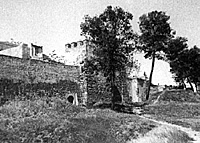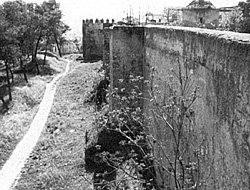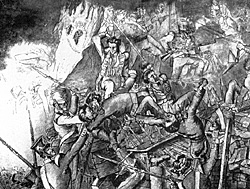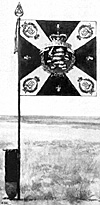The storming of the fortress town of Badajoz on the night
of April 6th 1812 remains one of the greatest achievements of Wellington's army in the
Peninsula. It was a bloody and savage episode, the breaches on the morning of April 7th presenting a harrowing sight, being a mass of broken, smoking and shattered bodies. Indeed, when Wellington visited the scene it caused him to shed tears for the first time in the war, something which he would do on only one other occasion in the Peninsula. And then there was the
terrifying aftermath, a display of drunken savagery, debauchery and destruction by the victorious stormers who, driven to the point of madness by the fury of their assaults, turned on the town, the people and its property in a devastating show of power which has gone down as
one of the most shameful episodes in the long and very illustrious history of the British army.
Misery and Mistrust
Badajoz had long been a cause of great misery and mistrust among Wellington's men, which
dated back to the late summer of 1809 when, following the battle of Talavera, British wounded were left behind in the supposed tender care of their Spanish allies, only to find that, far from proving benevolent they treated them with scant respect and even less care than if they
had been French troops. Indeed, Badajoz was regarded as having a very large proportion of Afrancecados, Spaniards who sided with the cause of Bonaparte and would have given anything to see their country rid of the despised English heretics. And when Wellington's army besieged the town twice in the spring and summer of 1811 and again in March and April 1812, rumours of
Spaniards firing at the besiegers from the walls of the town were rife throughout the Allied camp.
And what a miserable camp it was too -- particularly during the third siege -- with persistent heavy rain falling throughout March, making conditions in the trenches almost unbearable, with French artillery sending over round shot and common shell all day long
into the mud-filled trenches, the liquid mud ramparts affording little protection. It was a thoroughly unpleasant experience but it was one to which the besiegers applied themselves with great credit, given that digging was regarded as little more than navvies' work.
This was not the sort of life they had envisaged when they took the King's shilling, but they stuck at it, knowing that just a few hundred yards away, behind the forbidding walls of the town, lay plunder, drink, women and the rare chance to break the shackles of army discipline. The fact that this freedom would last for a whole seventy-two hours probably never entered
their minds at the time and, indeed, when the army staggered away from the town afterwards it is safe to say that it must have been surprised and shocked at the extent and duration of the riot. But all of this must have seemed a world away during the cold, miserable days of March when, such was the intensity of the downpour of rain that Jones, the great historian of the sieges in the Peninsula, was moved to write that March 23rd and 24th were perhaps two of the most dreadful recorded in the annals of sieges.
Pressing On
The siege pressed on until the first days of April when, with French troops marching to relieve Badajoz, Wellington began to turn his mind to the actual storming. He had hoped that, given enough time, he would be able to force the governor, Armand Phillipon, to surrender, whether through starvation or purely through the garrison's hopeless situation. But now, with
Soult coming up from Andalucia, this seemed unlikely and the unhappy prospect of committing his men to the assault -- flesh and blood against fire and stone -- became all too real.
Throughout the first week of April 1812, Wellington's gunners pounded away at the walls until by the evening of April 6th three breaches had been made in the walls; in the Santa Maria bastion, in the Trinidad bastion and in the curtain wall between them. These were to be assaulted by the 4th and Light Divisions. Then there were the two diversionary attacks at the
castle and at the San Vincente bastion. Both of these attacks, by the 3rd and 5th Divisions respectively, were to be carried out by means of escalade, a tremendous task given the height of the walls -- some 40 feet -- and the fact that the scaling ladders used to scale the walls
of the San Vincente bastion were too short.
Of course, under the laws of war current at the time, Phillipon and his garrison should have surrendered when summoned to do so by Wellington. The breaches were deemed 'practicable' and any men killed whilst attacking the place would have been regarded by the stormers as being killed unnecessarily.
The stormers would then, in theory, have the privilege of slaughtering the garrison afterwards. In other words, if a garrison fought on when 'practicable' breaches had been made, it waived all rights to mercy in the event of a successful storming. It was one of Napoleon's decrees that none of his garrison commanders should ever surrender a fortress without first having sustained at least one assault. Well, as we shall see, Phillipon and his men were to see off over forty separate attacks by the 4th and Light Divisions and yet, curiously, they emerged from the carnage on April 7th as prisoners-of-war and with their lives spared. As we know, it was the unfortunate population who bore the brunt of the anger of Wellington's battle-crazed men afterwards.
The evening of April 6th 1812 was one of the most momentous of the Peninsular War as Wellington's men prepared themselves for what was likely to be a very bad night indeed. And yet, even though they knew that each of them stood a more than even chance of ending the night as a blackened corpse, none shrank from the task before them. We do not have time to go into the
reasons' why this was so, since to say the prospect of drink and plunder, the flavour which they had tasted all too briefly, at Ciudad Rodrigo three months before, drove them on, (as did the desire to even the score following two previous successful defences of the town by the French in 1811 and, of course, there was the misery under which they had laboured for the past few weeks. Here was the opportunity for vengeance. The hour for retribution had arrived. The charged atmosphere was never better' summed up than by William Grattan, of the 88th (Connaught Rangers), who wrote,
Grattan's foreboding was as chilling as it was unfortunately accurate.
The hour finally came and shortly before ten o'clock, the storming columns moved silently forward! through the darkness, a rising mist from the river Guadiana adding to the eerieness of the situation. There are scarcely words to describe the horrors of what happened during the next three hours to Wellington's men, faced by huge walls, tenacious defenders and a whole host of deviously savage methods of defence, threw themselves into the breaches and up scaling ladders to assault the walls. But what did happen was little short of miraculous. Even Wellington, watching anxiously from a distance as his men were pushed to the absolute limits, must have wondered whether his men, who had never failed him yet, were capable of breaking in.
40th Time
And, indeed, as the bugles blew, summoning his men to reform for a fortieth time, Wellington, his face lit by the light of a torch, was seen to be visibly shaken by what was happening in
font of him, by the screams and shouts, and by the fiery flashes and explosions as his men were consumed by what appeared to be a volcano. And yet, even as he began to despair, a messenger arrived with the astonishing news that the 3rd Division had taken the castle.
While Sir Thomas Picton, the firebrand commander of the 3rd Division, lay nursing a wound at the foot of the castle walls, his men somehow man raged to gain the ramparts. More and more men poured over the walls until, faced with the inevitable, the French defenders fell back, literally locking the door behind them, for the castle, in reality, is not a castle. It is an enclosed area, surrounded by high walls, which was once a Moorish alcazar and was certainly not a castle in the normal sense of the word. True, there were and still are a couple of towers there, but the castle of Badajoz is really a large enclosed area which was to serve as a place of last refuge for the French in the event of a successful storming by Wellington's men.
Now that the castle had fallen, however, the plan was redundant and the French pulled out, closing behind them the gate which led from the castle into the town itself. Having finally gained the castle walls, however, the men of the 3rd Division were not going to let a simple wicker gate come between them and their cherished prize and, after a short while, the gate was
forced and the men poured into the street and into the Plaza Alta, their bugles blowing in advance.
While all this was going on, Leith's 5th Division had performed similar heroics at the San Vincente bastion, scaling the high walls with ladders too short for the purpose. Indeed, the men at the top of the ladders held tight whilst others scrambled on top of their shoulders and,
in some cases on to the shoulders of those on top of theirs. In so doing, this crude but effective balancing act allowed the stormers to gain the ramparts and soon they too were advancing into the town. Meanwhile, the Light and 4th Divisions were still hurling themselves
against the breaches but, like waves breaking over rocks, each tide receded leaving an ever growing high tide of dead and wounded bodies. In fact, the French defenders, growing confident in their ability to deal death all around them, stepped forward into the glare of the explosions to taunt their assailants with cries of 'why don't you come into Badajoz?'
Little did they know that, away to their right and left, they already had. Above the din and roar of battle at the breaches the wail of bugles could be heard in the streets behind them at which the defenders, shocked rigid by the sound knew the time for heroics was at an end and self preservation the priority. One by one they began to stream away from the breaches and make for the centre of town where Phillipon and his staff were gathered.
With the news that the castle had fallen, Phillipon knew there was little chance of turning back the tide and so, mounting his horse, he rode out of the Las Palmas gate with his staff, crossed the old Roman bridge and rode up into the Fort San Christoval where, at around one
o'clock on the morning of April 7th, he surrendered to Fitzroy Somerset. Badajoz was won.
Aftermath
We need not dwell on the aftermath of the storming of Badajoz. It was a terrible episode which, although hard to condone, is easy to understand for one would never blame Wellington's men, pushed to the very limits of human endurance, for letting loose their pent up anger upon the unfortunate people of Badajoz. Indeed, it is significant that, despite the erection of a
gallows in the Plaza Alta, no British troops are recorded as having been executed -- a popular myth I suspect--although the site of the gallows probably brought more than a few of the delinquents to their senses.
`The turmoil subsided rather than was quelled,' was Napier's comment. I suspect that
Wellington had not the heart to expend more lives than he already had in saving his honour. Indeed, such was the great achievement of Wellington's men that he himself -- never one to lavish praise on 'the scum of the earth' -- was moved to write, 'the storming of Badajoz affords as strong an instance of the gallantry of the British soldier as has ever been
displayed, but I great/y hope that I shall never again be the instrument of putting them to such a test as that to which they were put last night.'
The 88th (Connaught Rangers) played a major part in the storming of Badajoz, scaling the walls of the castle as part of Pictons famous 'Fighting' 3rd Division and suffering 145 casualties. Because of the nature of the operation, a storming, the men were allowed to leave
their packs behind; after all, there would be little use for them during the storming itself.
This was not an uncommon occurrence and, in fact, during the operations on the Bidassoa and Nivelle in October and November 1813, the Light Division asked per mission to discard their packs before attacking their objectives on the Bayonet Ridge and on the Lesser Rhune. Added to this was the condition of the men's uniforms, which would have been pretty bad, as was their personal appearance, having been exposed to all sorts of weather conditions during the past three years since arriving in the Peninsula in 1809. We are indebted to William Grattan, of the 88th, for leaving us the following description of the men as they prepared to storm Badajoz.
While the 88th covered itself with glory at Badajoz, it was a far different story for the men they had fought, the defenders of the castle, amongst whom were 910 men of the Hesse D'Armstdadt Regiment, German troops fighting in the service of France. The Hessians had
been in the Peninsula since 1808 and were regarded as excellent troops.
They had already served as part of the garrison of Seville but Badajoz was to be a far tougher prospect. The majority of the Hessians found themselves as part of the unit defending the castle on the night of April 6th 1812 and were probably responsible for a large proportion
of British casualties that night and could consider themselves fairly fortunate, therefore, that the successful stormers did not slaughter them out of hand. After all, the same had happened to a group of Italians at Ciudad Rodrigo who, after firing at their assailants to the very last moment, threw down their arms and pleaded for mercy which, naturally enough, was not given.
Indeed, there seems to have been a strange sort of bond between the soldiers of Britain and France which did not extend to either the Portuguese and Spaniards, or to the allied troops fighting for the French, such as the Germans and Italians. In fact, of the 910 Germans who
defended Badajoz, only 444 lived long enough to surrender. The subsequent history of these unfortunate men is reflected in the fact that just 183 reached their homeland at the end of the war as a result of the poor treatment they received as POWs.
Note: Ian Fletcher's classic account of the siege and storming of Badajoz, In Hell Before Daylight, has just been reprinted in paperback form by Spellmount Ltd. And is available from Caliver Books.
Badajoz Uniforms: 88th Foot and Hesse-Darmstadt Regt (slow: 183K) Plate 1. The walls of Badajoz. It was along this section that the 3rd Division places its ladders to escalade the castle. As you can see, it isn't really a castle at all, but is merely an enclosure which once included the old Moorish alcazar.
Plate 1. The walls of Badajoz. It was along this section that the 3rd Division places its ladders to escalade the castle. As you can see, it isn't really a castle at all, but is merely an enclosure which once included the old Moorish alcazar.
"NO FATIGUE COULD DAMP"
'The spirits of the soldiers, which no fatigue could damp, rose to a
frightful height..there was a certain something In their bearing
that told plainly that they had suffered fatigues, which; they did
not complain of, and had seen their comrades and offcers slain
while fighting beside them without repining, but that they had
smarted under the one, anal felt acutely for the other; they
smothered both, so long as their minds and bodies were
employed; now, however, that they had a momentary license to
think, every fine feeling vanished, and plunder and revenge took
their place..ln a word, the capture of Badajoz had long been their
idol. Many causes led to this wish on their part; the two previous
unsuccessful sieges, and the failure of the attack against San
Christoval in the latter; but above all, the well-known hostility of
its inhabitants to the British army, and perhaps might be added a
desire for plunder, which the sacking of Rodrigo had given them
a taste for. Badajoz was, therefore, denounced as a place to be
made an example of; and, most unquestionably, no city, Jerusalem
exempted was ever more strictly visited to the letter than was this
ill-fated town.''
 Plate 2. A defender's view from the walls of Badajoz. The enormity of the task facing the 3rd Division can be appreciated here. The walls are over forty feet high here and, once at the top of the ladders, the men of the 3rd Division were easy game for the defenders. A simple stab with either a bayonet or sword or the discharge of a musket into the face of the attacker was enough to see him off. The ditch at the foot of the walls, now a path in this photo, was the scene of much chaos and carnage as the men waited impatiently to get up.
Plate 2. A defender's view from the walls of Badajoz. The enormity of the task facing the 3rd Division can be appreciated here. The walls are over forty feet high here and, once at the top of the ladders, the men of the 3rd Division were easy game for the defenders. A simple stab with either a bayonet or sword or the discharge of a musket into the face of the attacker was enough to see him off. The ditch at the foot of the walls, now a path in this photo, was the scene of much chaos and carnage as the men waited impatiently to get up.
 Plate 4. 'The Storming of Badajoz by the 83rd Regiment, 1812.' This unusual picture was drawn by Captain Marshman, 28th Regiment, in 1870. Although there are many anachronisms as far as uniforms are concerned -- bell-top shakos, etc, -- the ferocity of the fighting can hardly be more effectively shown. The two characters on the left certainly have wild expressions. Elsewhere, axes and bayonets are used to great effect. Note also the chevaux-de-frise; planks of wood bristling with spikes and bayonets. All in all a good representation of the attack on the castle walls at Badaioz.
Plate 4. 'The Storming of Badajoz by the 83rd Regiment, 1812.' This unusual picture was drawn by Captain Marshman, 28th Regiment, in 1870. Although there are many anachronisms as far as uniforms are concerned -- bell-top shakos, etc, -- the ferocity of the fighting can hardly be more effectively shown. The two characters on the left certainly have wild expressions. Elsewhere, axes and bayonets are used to great effect. Note also the chevaux-de-frise; planks of wood bristling with spikes and bayonets. All in all a good representation of the attack on the castle walls at Badaioz.
THE PLATES
'All was now in readiness. It was twenty-five minutes past nine; the soldiers, unencumbered with their knapsacks -- their stocks off -- their shirt-collars unbuttoned -- their trousers tucked up to the knee -- their tattered jackets, so wom out as to render the regiment they belonged to barely recognisable -- their huge whiskers and bronzed faces, which several hard-fought campaigns had changed from their natural hue -- but, above all, their self-confidence, devoid of boast or bravado, gave them the appearance of what they in reality were -- an invincible host.'
 Plate 3. The flag of the Hesse D'Armstadt Regiment, taken by Private George Hatton, of the 4th Foot. Curiously enough, the 4th Foot was part of the 5th Division which attacked on the
other side of the town. Hatton took the flag from those Hessians who were fighting at the San Vincente Bastion. The flag once hung from the ceiling of the Chapel in the Royal
Hospital, Chelsea, until it was removed by a disgruntled Frenchman.
Plate 3. The flag of the Hesse D'Armstadt Regiment, taken by Private George Hatton, of the 4th Foot. Curiously enough, the 4th Foot was part of the 5th Division which attacked on the
other side of the town. Hatton took the flag from those Hessians who were fighting at the San Vincente Bastion. The flag once hung from the ceiling of the Chapel in the Royal
Hospital, Chelsea, until it was removed by a disgruntled Frenchman.
Back to Age of Napoleon No. 28 Table of Contents
Back to Age of Napoleon List of Issues
Back to MagWeb Master List of Magazines
© Copyright 1998 by Partizan Press.
This article appears in MagWeb (Magazine Web) on the Internet World Wide Web.
Other military history articles and gaming articles are available at http://www.magweb.com